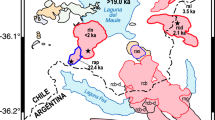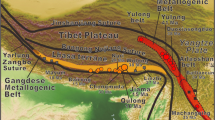Abstract
Reaction zones around minerals in mantle xenoliths have been reported from many localities worldwide. Interpretations of the origins of these textures fall into two groups: mantle metasomatic reaction or reaction during transport of the xenoliths to the surface. A suite of harzburgitic mantle xenoliths from Sal, Cape Verde show clear evidence of reaction during transport. The reactions resulted in the formation of olivine–clinopyroxene and Si- and alkali-rich glass reaction zones around orthopyroxene and sieve-textured clinopyroxene and sieve textured spinel, both of which are associated with a Si- and alkali-rich glass similar to that in the orthopyroxene reaction zones. Reaction occurred at pressures less than the mantle equilibration pressure and at temperatures close to the liquidus temperature of the host magma. In addition, there is a clear spatial relation of reaction with the host lava: reaction is most intense near the lava/xenolith contact. The residence time of the xenoliths in the host magma, determined from Fe–Mg interdiffusion profiles in olivine, was approximately 4 years. Our results cannot be reconciled with a recent model for the evolution of the mantle below the Cape Verde Archipelago involving mantle metasomatism by kimberlitic melt. We contend that alkali-rich glasses in the Sal xenoliths are not remnants of a kimberlitic melt, but rather they are the result of reaction between the host lava or a similar magma and xenolith minerals, in particular orthopyroxene. The formation of a Si- and alkali-rich glass by host magma–orthopyroxene reaction appears to be a necessary precursor to formation of sieve textured spinel and clinopyroxene.












Similar content being viewed by others
References
Bonadiman C, Beccaluva L, Coltorti M, Siena F (2005) Kimberlite-like Metasomatism and ’Garnet Signature’ in spinel-peridotite xenoliths from sal, Cape Verde archipelago: relics of a subcontinental Mantle domain within the Atlantic oceanic lithosphere. J Petrol 46(12):2465–2493
Brearley M, Scarfe CM, Fujii T (1984) The petrology of ultramafic xenoliths from Summit Lake, near Prince George, British Columbia. Contrib Mineral Petrol 88:53–63
Brey GP, Köhler T (1990) Geothermobarometry in four-phase lherzolites II. New thermobarometers and practical assessment of existing thermobarometers. J Petrol 31: 1353–1378
Buening DK, Buseck PR (1973) Fe–Mg lattice diffusion in olivine. J Geophys Res 78:6852–6862
BVSP (1981) Ultramafic xenoliths in terrestrial volcanics and mantle magmatic processes, basaltic volcanism on the terrestrial planets. LPI, pp 282–310
Carpenter RL, Edgar AD, Thibault Y (2002) Origin of spongy textures in clinopyroxene and spinel from mantle xenoliths, Hessian depression, Germany. Mineral Petrol 74:149–162
Chakraborty S (1997) Rates and mechanisms of Fe–Mg interdiffusion in olivine at 980° to 1300°C. J Geophys Res 102(B6):12317–12331
Coltorti M, Beccaluva L, Bonadiman C, Salvini L, Siena F (2000a) Glasses in mantle xenoliths as geochemical indicators of metasomatic agents. Earth Planet Sci Lett 183:303–320
Coltorti M, Beccaluva L, Bonadiman C, Siena F (2000b) K-rich glasses from the oceanic mantle of Cape Verde. J Conf Abstr 5(2):316
Costa F, Chakraborty S (2004) Decadal time gaps between mafic intrusion and silicic eruption obtained from chemical zoning patterns in olivine. Earth Planet Sci Lett 227:517–530
Doucelance R, Escrig S, Moreira M, Gariepy C, Kurz MD (2003) Pb-Sr-He isotope and trace element geochemistry of the Cape Verde Archipelago. Geochim Cosmochim Acta 67:3717–3733
Ghiorso MS, Sack RO (1995) Chemical mass transfer in magmatic processes. IV. A revised and internally consistent thermodynamic model for the interpolation and extrapolation of liquid–solid equilibria in magmatic systems at elevated temperatures and pressures. Contrib Mineral Petrol 119:197–212
Hirose K, Kawamoto T (1995) Hydrous partial melting of lherzolite at 1 GPa: the effect of H2O on the genesis of basaltic magmas. Earth Planet Sci Lett 133:463–473
Ionov DA, Hofmann AW, Shimizu N (1994) Metasomatism-induced melting in mantle xenoliths from Mongolia. J Petrol 35:753–785
Kelemen PB, Dick HJB, Quick JE (1992) Formation of harzburgite by pervasive melt/rock reaction in the upper mantle. Nature 358:635–641
Klügel A (1998) Reactions between mantle xenoliths and host magma beneath La Palma (Canary Islands): constraints on magma ascent rates and crustal reservoirs. Contrib Mineral Petrol 131:237–257
Klügel A (2001a) Prolonged reactions between harzburgite xenoliths and silica-undersaturated melt: implications for dissolution and Fe–Mg interdiffusion rates of orthopyroxene. Contrib Mineral Petrol 141:1–14
Klügel A (2001b) Comment on "Silicic melts produced by reaction between peridotite and infiltrating basaltic melts: ion probe data on glasses and minerals in veined xenoliths from La Palma, Canary Islands" by Wulff-Pedersen et al. Contrib Mineral Petrol 141:1–14
Köhler TP, Brey GP (1990) Calcium exchange between olivine and clinopyroxene calibrated as a geothermobarometer for natural peridotites from 2 to 60 kb with applications. Geochim Cosmochim Acta 54:2375–2388
Liang Y, Elthon D (1990) Geochemistry and Petrology of Spinel Lherzolite Xenoliths From Xalapasco de La Joya, San Luis Potosi, Mexico: partial melting and mantle metasomatism. J Geophys Res B95:15859–15877
Morimoto N, Fabries J, Ferguson AK, Ginzburg IV, Ross M, Seifert FA, Zussman J, Aoki K, Gottardi G (1988) Nomenclature of pyroxenes. Am Mineral 73(9–10):1123–1133
de Paepe P, Klerkx J (1971) Peridotite nodules in nephelinites from Sal (Cape Verde Islands). Ann Soc Géol Belg 41:311–316
Pike JEN, Schwarzman EC (1976) Classification of textures in ultramafic xenoliths. J Geol 85:49–61
Qi Q, Taylor LA, Zhou X (1995) Petrology and geochemistry of mantle peridotite xenoliths from SE China. J Petrol 36:55–79
Ryabchikov ID, Ntaflos N, Kurat G, Kogarko LN (1995) Glass-bearing xenoliths from Cape Verde: evidence for a hot rising mantle jet. Mineral Petrol 55:217–238
Shaw CSJ (1999) Dissolution of orthopyroxene in basanitic magma between 04 and 2 GPa: further implications for the origin of Si-rich alkaline glass inclusions in mantle xenoliths. Contrib Mineral Petrol 135:114–132
Shaw CSJ (2004) The temporal evolution of three magmatic systems in the West Eifel volcanic field, Germany. J Volcanol Geothermal Res 131:213–240
Shaw CSJ, Edgar AD (1997) Post-entrainment mineral-melt reactions in spinel peridotite xenoliths from Inver, Donegal, Ireland. Geol Mag 134:771–779
Shaw CSJ, Klügel A (2002) The pressure and temperature conditions and timing of glass formation in mantle-derived xenoliths from Baarley, West Eifel, Germany: the case for amphibole breakdown, lava infiltration and mineral-melt reaction. Mineral Petrol 74:163–187
Shaw CSJ, Thibault Y, Edgar AD, Lloyd FE (1998) Mechanisms of orthopyroxene dissolution in silica-undersaturated melts at 1 atmosphere and implications for the origin of silica-rich glass in mantle xenoliths. Contrib Mineral Petrol 132:354–370
Shaw CSJ, Eyzaguirre J, Fryer BJ, Gagnon J (2005) Regional variations in the mineralogy of metasomatic assemblages in mantle xenoliths from the West Eifel Volcanic Field, Germany. J Petrol 46:945–972
Wilde WT, Rees WJ (1943) Ternary system MgO−Al2O3−Cr2O3. Trans Br Ceram Soc 42:123–155
Wulff-Pedersen E, Neumann E-R, Vannucci R, Botazzi P, Ottolini L (1999) Silicic melts produced by reaction between peridotite and infiltrating basaltic melts: ion probe data on glasses and minerals in veined xenoliths from La Palma, Canary Islands. Contrib Mineral Petrol 137:59–82
Acknowledgments
This work was funded by an NSERC Discovery grant to CSJS. Thanks to Oskar Leitner of the Bayerisches Geoinstitut for preparing the thin sections and Douglas Hall and Ryan Barr for their assistance with electron microprobe analyses. Thanks also to Alex Rocholl for his comments on an earlier version of this manuscript. We are grateful to Andreas Klügel and Dante Canil for their comprehensive and constructive reviews.
Author information
Authors and Affiliations
Corresponding author
Additional information
Communicated by J. Hoefs
Rights and permissions
About this article
Cite this article
Shaw, C.S.J., Heidelbach, F. & Dingwell, D.B. The origin of reaction textures in mantle peridotite xenoliths from Sal Island, Cape Verde: the case for “metasomatism” by the host lava. Contrib Mineral Petrol 151, 681–697 (2006). https://doi.org/10.1007/s00410-006-0087-2
Received:
Accepted:
Published:
Issue Date:
DOI: https://doi.org/10.1007/s00410-006-0087-2




